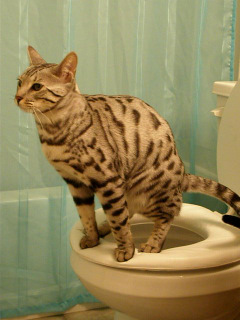The Dangers of Flushing Cat Poop Down Your Toilet - Advice for Safer Disposal
The Dangers of Flushing Cat Poop Down Your Toilet - Advice for Safer Disposal
Blog Article
How do you feel when it comes to Can You Flush Cat Poo or Litter Down the Toilet??

Introduction
As pet cat owners, it's necessary to be mindful of just how we throw away our feline pals' waste. While it may appear convenient to purge feline poop down the commode, this technique can have damaging consequences for both the setting and human health and wellness.
Alternatives to Flushing
Fortunately, there are more secure and a lot more responsible methods to deal with pet cat poop. Think about the following choices:
1. Scoop and Dispose in Trash
The most usual technique of dealing with pet cat poop is to scoop it into an eco-friendly bag and throw it in the garbage. Be sure to make use of a dedicated clutter scoop and dispose of the waste without delay.
2. Use Biodegradable Litter
Select biodegradable pet cat trash made from products such as corn or wheat. These trashes are eco-friendly and can be safely taken care of in the garbage.
3. Bury in the Yard
If you have a lawn, consider burying pet cat waste in a designated location far from vegetable yards and water resources. Make sure to dig deep enough to stop contamination of groundwater.
4. Set Up a Pet Waste Disposal System
Buy a pet garbage disposal system specifically created for pet cat waste. These systems use enzymes to break down the waste, minimizing smell and environmental effect.
Wellness Risks
Along with environmental issues, purging pet cat waste can also position health and wellness threats to humans. Cat feces may consist of Toxoplasma gondii, a bloodsucker that can trigger toxoplasmosis-- a possibly extreme illness, particularly for expecting ladies and individuals with damaged body immune systems.
Ecological Impact
Flushing cat poop introduces unsafe virus and bloodsuckers into the water supply, positioning a considerable danger to water ecological communities. These impurities can adversely influence aquatic life and concession water high quality.
Final thought
Accountable family pet ownership prolongs beyond offering food and shelter-- it also includes appropriate waste administration. By avoiding purging cat poop down the toilet and choosing alternate disposal techniques, we can decrease our ecological impact and shield human wellness.
Why Can’t I Flush Cat Poop?
It Spreads a Parasite
Cats are frequently infected with a parasite called toxoplasma gondii. The parasite causes an infection called toxoplasmosis. It is usually harmless to cats. The parasite only uses cat poop as a host for its eggs. Otherwise, the cat’s immune system usually keeps the infection at low enough levels to maintain its own health. But it does not stop the develop of eggs. These eggs are tiny and surprisingly tough. They may survive for a year before they begin to grow. But that’s the problem.
Our wastewater system is not designed to deal with toxoplasmosis eggs. Instead, most eggs will flush from your toilet into sewers and wastewater management plants. After the sewage is treated for many other harmful things in it, it is typically released into local rivers, lakes, or oceans. Here, the toxoplasmosis eggs can find new hosts, including starfish, crabs, otters, and many other wildlife. For many, this is a significant risk to their health. Toxoplasmosis can also end up infecting water sources that are important for agriculture, which means our deer, pigs, and sheep can get infected too.
Is There Risk to Humans?
There can be a risk to human life from flushing cat poop down the toilet. If you do so, the parasites from your cat’s poop can end up in shellfish, game animals, or livestock. If this meat is then served raw or undercooked, the people who eat it can get sick.
In fact, according to the CDC, 40 million people in the United States are infected with toxoplasma gondii. They get it from exposure to infected seafood, or from some kind of cat poop contamination, like drinking from a stream that is contaminated or touching anything that has come into contact with cat poop. That includes just cleaning a cat litter box.
Most people who get infected with these parasites will not develop any symptoms. However, for pregnant women or for those with compromised immune systems, the parasite can cause severe health problems.
How to Handle Cat Poop
The best way to handle cat poop is actually to clean the box more often. The eggs that the parasite sheds will not become active until one to five days after the cat poops. That means that if you clean daily, you’re much less likely to come into direct contact with infectious eggs.
That said, always dispose of cat poop in the garbage and not down the toilet. Wash your hands before and after you clean the litter box, and bring the bag of poop right outside to your garbage bins.
https://trenchlesssolutionsusa.com/why-cant-i-flush-cat-poop/

As an avid person who reads on How to Dispose of Cat Poop and Litter Without Plastic Bags, I was thinking sharing that piece of content was beneficial. Are you aware of someone else who is curious about the topic? Do not hesitate to promote it. Thank you for your time. Kindly pay a visit to our site back soon.
Free Quote Report this page